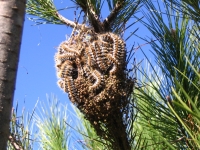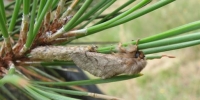GenoPheno: Genomics of phenology in the pine processionary moth
Project coordinator:
Carole Kerdelhué, Mathieu Gautier, Laure Sauné, Bernhard Gschlössl, Franck Dorkeld
Centre de Biologie pour la Gestion des Populations (CBGP)
755 avenue du Campus Agropolis
CS 30016, 34988 Montferrier / Lez cedex, France
Abstract:
This project aims at developing population genomics approaches to identify loci potentially linked to the evolution of phenology in the pine processionary moth Thaumetopoea pityocampa.
We took advantage of the occurrence in Portugal of a natural mutant population of this species that exhibits a strongly shifted life cycle (reproduction in May and larval development in summer, vs. reproduction in summer and larval development in winter in all other populations).
To do so, we recently developed a large amount of genomic data, including a de novo preliminary reference genome, and transcriptomic data. The BAC libraries developed at CNRGV will be used to evaluate and possibly improve the quality of genome assembly, and obtain reliable sequences of genomic portions located near the loci of interest we will identify.
CNRGV's responsible:
Genseric Beydon
|
|
|
Photos credits: Christian Burban and Isabelle Pivotto, INRA
The pine processionary moth Thaumetopoea pityocampa (Lepidoptera: Notodontidae) is a forest insect occurring all around the Mediterranean basin, mostly on pines and cedars. Its larvae develop gregariously in winter in conspicuous silk nests, and feed on tree needles. In spring, they leave the tree in a typical head-to-tail procession in search for an under-ground pupation site. The species is currently expanding its range to the north and to higher altitudes following global warming, causing public health concern in the recently invaded regions due to its urticating caterpillars.
Publication related to the project:



